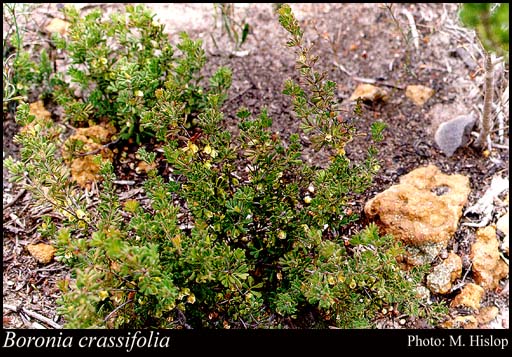- Reference
- Lehm., Pl.Preiss. [J.G.C.Lehmann] 1:169 (1845)
- Conservation Code
- Not threatened
- Naturalised Status
- Native to Western Australia
- Name Status
- Current
Multi-stemmed, spreading shrub, 0.1-0.3(-0.6) m high. Fl. white-cream-green, Aug to Dec. Grey/yellow sand, laterite. Sandplains, dunes.







Scientific Description
Shrub, spines absent; branchlets smooth, without distinct raised glands, +/- cylindrical in cross-section, covered in hairs or scales, the hairs simple. Leaves opposite, compound, 5-10 mm long, with 2-3 leaflets, each 7-11 mm long, 1.5-2 mm wide, flat, the margins flat, smooth, without distinct raised glands, glabrous; stipular excrescences absent. Flowers axillary, solitary; pedicels 2-2.5 mm long; calyx present, 2 mm long, smooth, without distinct raised glands, glabrous; corolla pink, white or cream or green, petals four, 5 mm long, imbricate (overlapping), free, glabrous; stamens twice as many as petals, with an appendage. Flowers in August, September, October, November and December. Occurs in the Eremaean and South-West Botanical Province, in the Hampton, Avon Wheatbelt, Jarrah Forest, Mallee, Esperance and Geraldton IBRA region(s).
Distribution
- IBRA Regions
- Avon Wheatbelt, Esperance Plains, Geraldton Sandplains, Hampton, Jarrah Forest, Mallee.
- IBRA Subregions
- Eastern Mallee, Fitzgerald, Hampton, Katanning, Lesueur Sandplain, Northern Jarrah Forest, Recherche, Southern Jarrah Forest, Western Mallee.
- Local Government Areas (LGAs)
- Albany, Beverley, Carnamah, Coorow, Cranbrook, Dandaragan, Dumbleyung, Dundas, Esperance, Gnowangerup, Jerramungup, Kent, Kondinin, Kulin, Lake Grace, Pingelly, Plantagenet, Ravensthorpe, Wagin, Wickepin, Williams, Woodanilling.